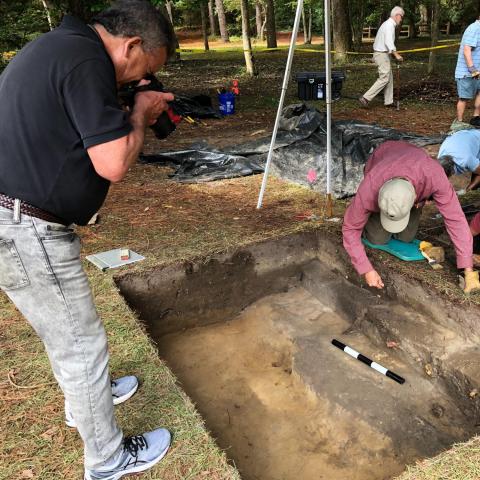It sounds like a page from the script of Jaws, a blockbuster 40 years old this summer in which a massive great white shark terrorizes a fictional New England beach town during the Fourth of July weekend.
No great white sharks are thought to be involved in the attacks at Cape Hatteras National Seashore, and there have been no deaths, but three separate incidents there in the past week have officials warning beach goers to stay out of the water if they fear sharks.
"We can never guarantee anyone’s safety when they enter the water. The only way to be sure you do not encounter sharks or other marine wildlife that may be harmful to humans, is to stay out of the water,” Cape Hatteras Superintendent David Hallac said in a prepared statement.
The attacks have ranged from Waves and Avon on the northern tier of the national seashore down to Ocracoke on the southern tip. The first was last Friday, when a 47-year-old man was bitten while swimming near Avon. The next day a 17-year-old was attacked near Waves. On Wednesday, a 68-year-old man was attacked at Ocracoke while swimming in front of the lifeguard station.
None of the injuries was thought to be life-threatening, though exact details of the injuries were not available from the seashore due to privacy issues. In the latest incident, the man received injuries to his ribcage, lower leg, hip and both hands. The 17-year-old received wounds to his right calf, buttocks, and both hands. In the other attack, the 47-year-old received injuries to his right leg and lower back.
“We really don’t know why there's been an increase of these incidents, but we just want to be sure our visitors are aware of them and have a safe visit while they’re here," seashore spokeswoman Cyndy Holda said Thursday during a phone interview. "We have stepped up the patrols, lifeguards are talking to people, patrols are talking to people, roving interpreters are talking to people about you swim at your own risk."
While the story-line in Jaws included a heated debate between the police chief and the mayor of fictional Amity Island over whether to close the beaches, at Cape Hatteras no such closure is being considered.
"The beach is a safe place to be and we’re not closing beaches," Ms. Holda said, adding that such a move would be highly unpopular with officials from Dare County and Hyde County "if the Park Service closed the beaches right here on the Fourth of July weekend."
"It’s just the water where it’s dangerous," she added.
Speculation as to why there have been so many attacks this summer -- 11 between North Carolina and South Carolina alone, according to Ms. Holda -- ranges from warmer waters driving prey farther north earlier than usual with sharks following to the simple fact that more people are seeking the ocean waters to cool off.
"I've heard everything under the sun, but I have yet to see a bonafide shark expert come out with any one definitive answer," the seashore spokeswoman said. "We think it is a combination of things. It could just be mass migration, it could be a little bit warmer than usual waters, it could be a lot of bait fish in the water, and then you top that with thousands of people trying to refresh themselves because we’ve had exceedingly hot temperatures for over a week now. Its been 90s and 100s, so we have a lot of people on the beach, a lot of people cooling off in the water.”
And unlike Cape Cod National Seashore in Massachuetts, where large populations of summering gray seals draw great white sharks, there is no resident seal population at Cape Hatteras that might attract sharks, said the spokeswoman.
That said, sharks are rather commonplace at Cape Hatteras, Ms. Holda added.
"When you fly over the area, you see sharks in the water all the time in the inlets. You’re just not cognizant that they’re even there," she said. "These are chasing after fish and anything that gets in the way.”
On average, the entire North Carolina coastline sees two shark attacks a year, according to the spokeswoman. At the national seashore, the last suspected attack was in 2012, but there was some question as to whether a shark was actually involved in the incident.
”This woman was standing in ankle-deep water and she sustained some fairly severe bites to her foot. She described it as a baby shark, but it could have been a bluefish," Ms. Holda recalled. "We don’t know in that situation.”
Prior to that, a young girl was bitten by what appeared to be a young shark while she was swimming at Ocracoke in 2011. The last known shark fatality at Cape Hatteras was in 2001, when a young Russian couple swam out to an off-shore sandbar and were attacked.
“It was a gruesome scene. The young man died, he bled out, and the young girl had bad shark bites on her body," said Ms. Holda.
According to Sea Grant North Carolina at North Carolina State University, the state's ocean waters, bays and inlets are home to a variety of shark species, from Atlantic sharpnose sharks, blacktip sharks, bonnethead sharks and bull sharks to dusky sharks, sand tiger sharks, and even the great white sharks. These sharks can range from 4 and 5 feet in length, in the case of the Atlantic sharpnose and bonnethead, to 18 feet for Tiger sharks and up to 21 feet for great whites, according to the university.
Despite the number of shark species in North Carolina's waters, experts say the risk of being bitten is small.
“Bees, wasps and snakes are responsible for more fatalities each year,” George Burgess, director of the International Shark Attack File in Florida, states in a brochure on sharks published by Sea Grant North Carolina. “The reality is that, on the list of potential dangers encountered in aquatic recreation, sharks are right at the bottom of the list.”





 Support Essential Coverage of Essential Places
Support Essential Coverage of Essential Places







Comments
This is the unintended consequences of shark and turtle conservation. There are way more sharks in these waters now there have been for a long time.
Jarvis!
All sharks are not dangerous. Great white, tiger and bull sharks are known to attack humans without any provocation. But these cases are rare.
Possibility of shark attack increases if there is blood in the water. Sharks can sense blood from miles away. They tend to come to that spot. If they think that the person is injured, they will attack.
Big sharks do not like to come too close to shore. So, you are safer there. Sometimes, sharks come to shallow water near the coral reefs. Watch for sharks if you love to dive around the coral reefs.
But you need not to panic. Your chance of being killed by a shark is extremely rare. Our roads are much more likely to kill you than the shark filled oceans.
Visit my website for more information about marine life: http://www.allfiveoceans.com/